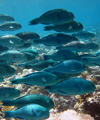March
Corals cope with hot water

Some corals may be able to adapt to changes in sea temperature, making them more resilient to climate change than previously thought.
An international team of researchers, including experts from Newcastle University, have studied corals in three places to see how they responded to a period of significantly hotter sea water in 2010.
At two sites they found a surprising reversal in the usual patterns of coral bleaching – the species generally thought to be most vulnerable having survived the higher temperatures better than their supposedly more resilient relatives.
Published today in the online journal PLoS One, this is the first time this effect has been seen during a major warming period. The research suggests it is linked to the frequency and severity of previous temperature changes, so corals in regions that have had more severe temperature fluctuations in the past had adapted and could stand the worst effects of the 2010 warming.
Coral bleaching happens when the symbiotic relationship between the coral and the coloured algae that live within its tissues breaks down. Unusally warm waters over a prolonged period damage the algae so they lose their colour and are expelled from the coral, which eventually dies.
Typically, the faster-growing, branching coral species, like staghorn corals, are considered more susceptible; they lose colour relatively quickly and whole colonies can die in just a couple of months.
In contrast, large species like brain corals are seen as resilient, because it takes them longer to bleach and fewer colonies die completely.
To see how the 2010 sea temperature rise had affected corals in different places, the researchers surveyed three reef sites, in Singapore, Tioman in Malaysia, and Pulau Weh in Indonesia.
The sites have similar communities of corals but have different histories of temperature change; for example the Singapore and Tioman sites were badly bleached by a sea-temperature rise in 1998 which hardly affected the reefs at Pulau Weh.
The team were surprised to discover the branching corals at Singapore and Tioman had fared better than the larger ones. They also found the bleaching at Pulau Weh had been far more severe, with 94 per cent of staghorn colonies dying compared to just 5 per cent in Singapore.
Co-author Professor Alasdair Edwards, based in the
School of Biology at Newcastle University, explains: "Suddenly the hierarchy of susceptibility appears to have broken down in certain locations.
"It's possible the corals that survived the 1998 warming have simply got used to higher temperatures. But we think it's more likely that natural selection is at work, with the few branching corals hardy enough to survive in 1998 reproducing and quickly repopulating the reefs with a hardier strain. By contrast, reefs sites like Pulau Weh that have had it easier remain vulnerable.
"We've seen from reef restoration work that you can settle out branching coral larvae and have a reproducing colony in just three to four years. Perhaps this rapid reproductive rate has enabled adaptation to occur with natural selection to favouring those stronger branching corals that weren't weeded out by the 1998 temperature rise."
The findings do not change the fact that global warming poses a significant threat to the world's coral reefs.
What they do show is that the corals' response to warming seas is more varied than previously thought. Coral reefs are critically important for the health of marine ecosystems, so understanding the reasons for this effect will be important for effective marine conservation plans, helping identify sites that are less vulnerable to global warming.
"So far we only have the observations," says Professor Edwards. "But this is a signal to the coral-reef research community that we need to identify survivors and the mechanisms by which they're surviving."
Source information: Guest JR, Baird AH, Maynard JA, Muttaqin E, Edwards AJ, et al, (2012) Contrasting patterns of coral bleaching susceptibility in 2010 suggest an adaptive response to thermal stress. PLoS ONE, 7(3): e33353. doi:10.1371/journal.pone.0033353
Press release courtesy of the Natural Environment Research Council (NERC)
published on: 29 March 2012
